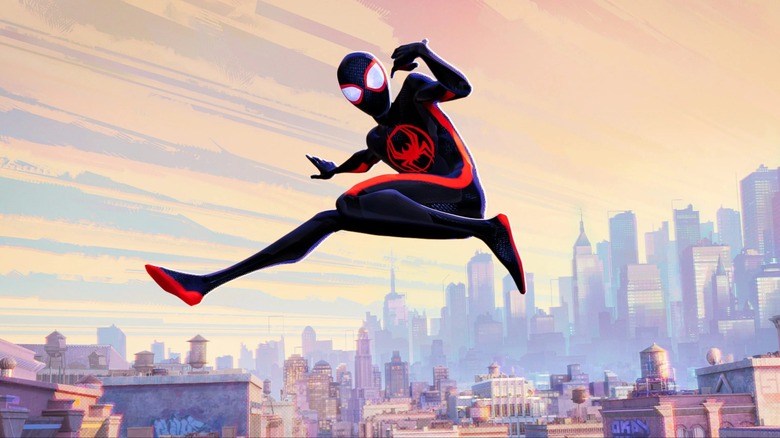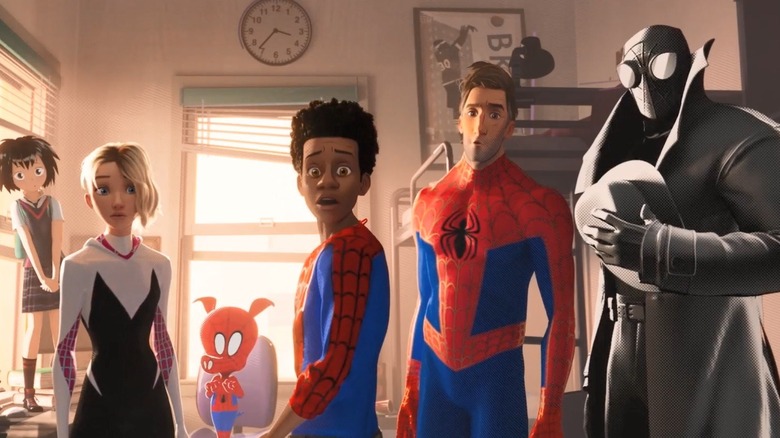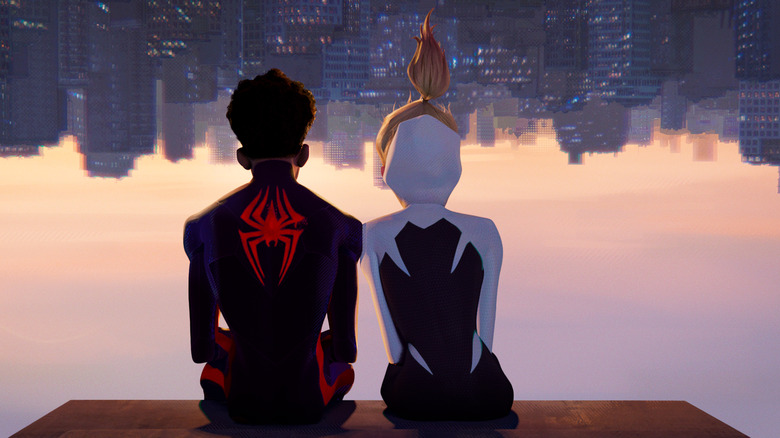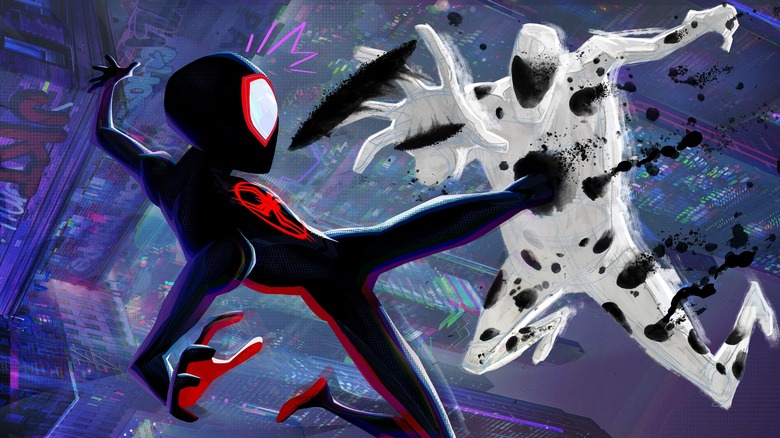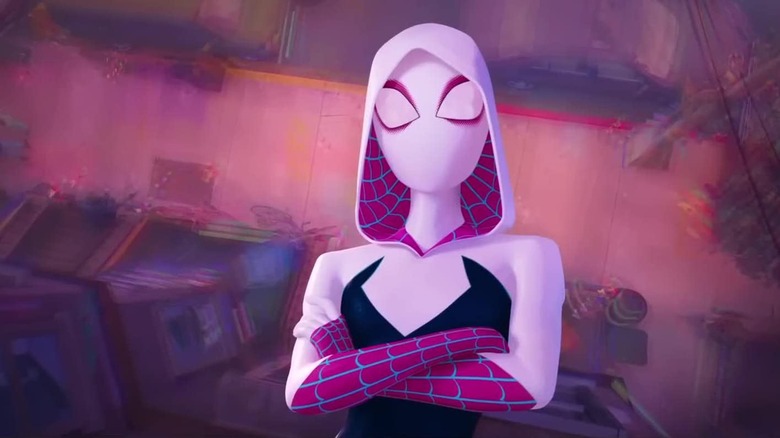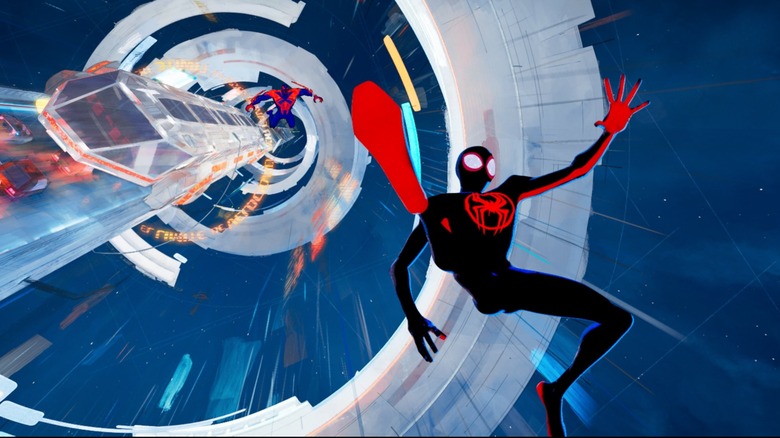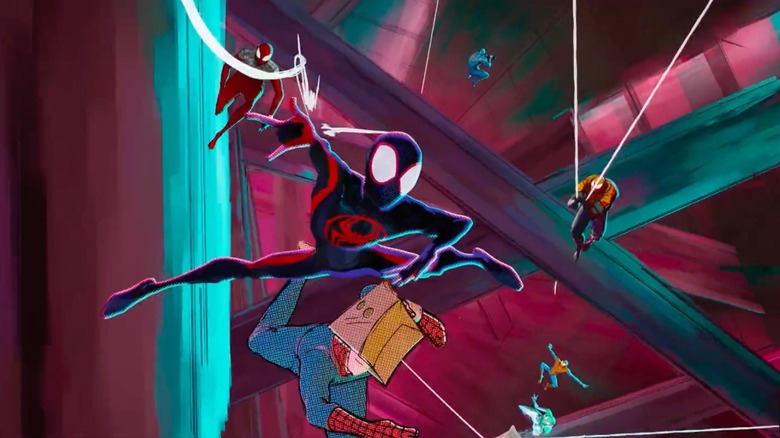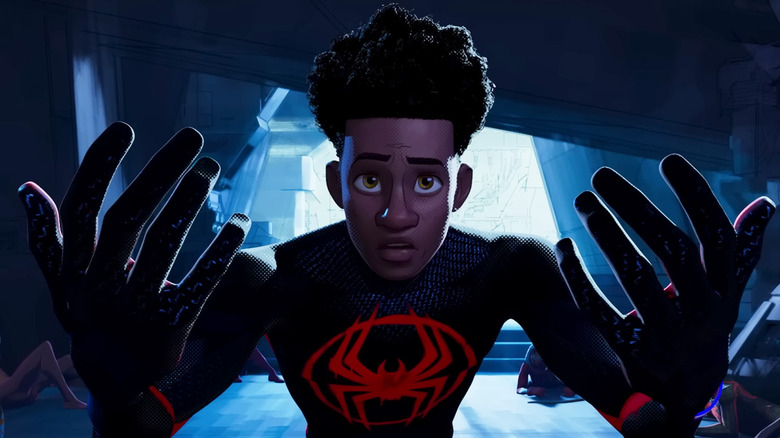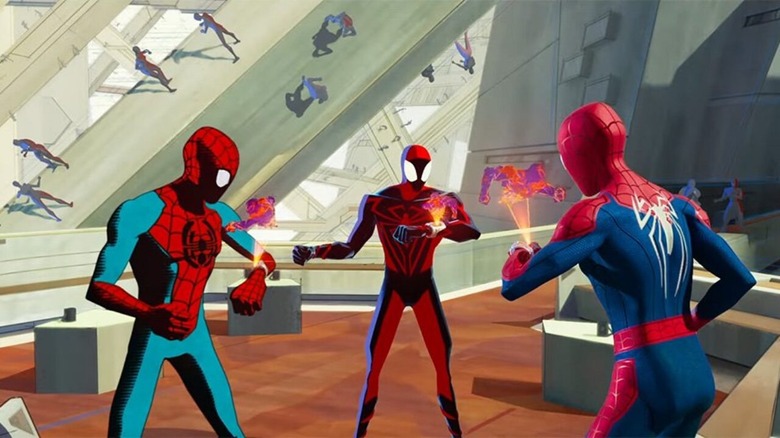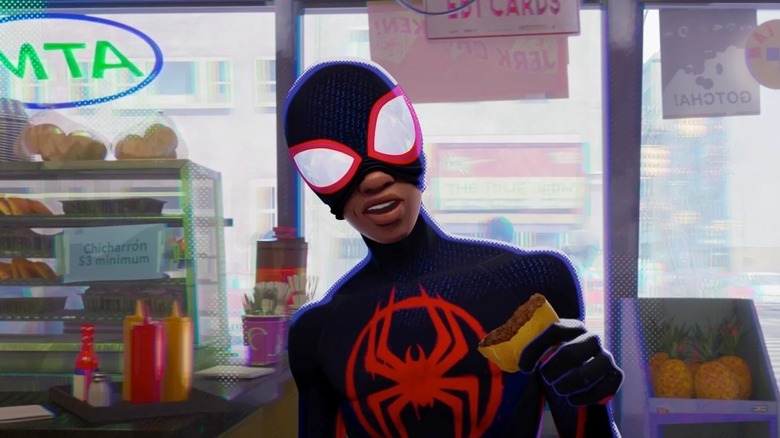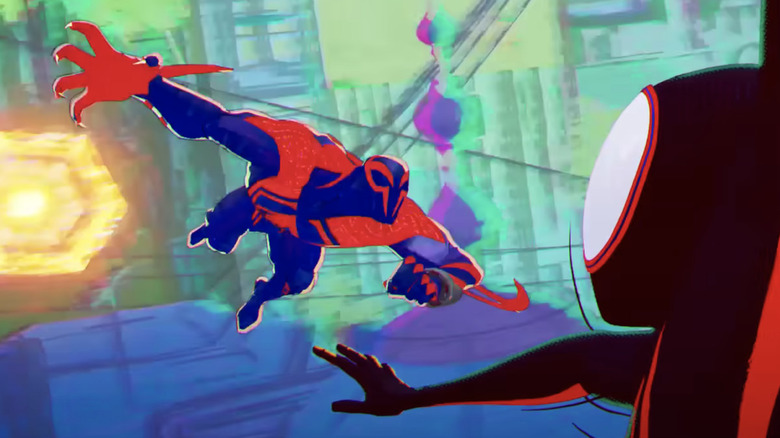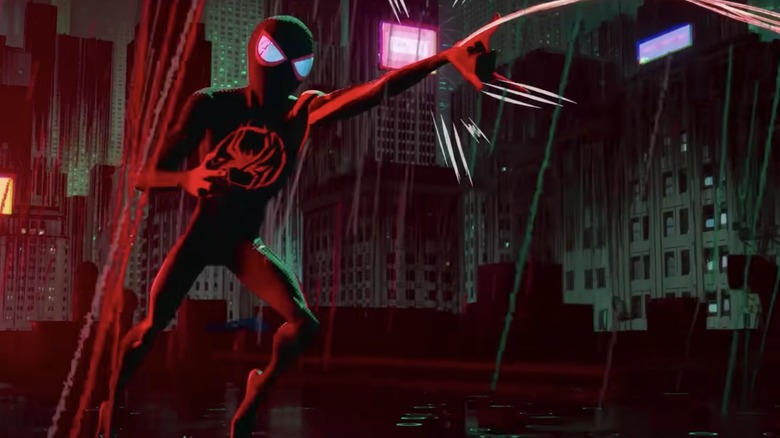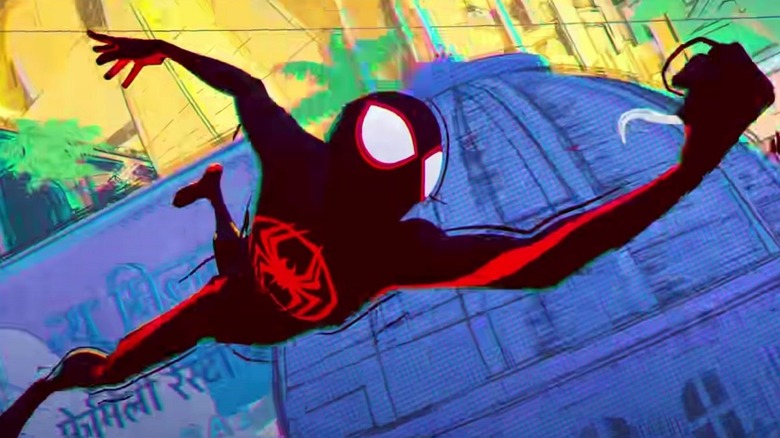The Untold Truth Of Spider-Man: Across The Spider-Verse
"Spider-Man: Across the Spider-Verse" is a movie all about exploring the unknown. Miles Morales (Shameik Moore) — now firmly cemented as his universe's Spider-Man — spends this film discovering new alternate universes and countless other versions of the web-slinging crime fighter. It's an exhilarating experience brought to life through a wide array of visual influences that build on the expansive visual palette of "Spider-Man: Into the Spider-Verse" and then some. Given how much exploration of the unprecedented informs the story of "Across the Spider-Verse," it's no surprise that the creative team behind this ambitious sequel was also embracing the unexpected in making this movie.
The untold truth of "Spider-Man: Across the Spider-Verse" covers the long journey this movie took from being a slew of bold ideas to a finished feature. This journey — which started before "Into the Spider-Verse" even hit theaters — covers everything from how COVID-19 impacted the release plans for this sequel, the biggest hurdles the animation team faced, what the individual creative focuses of the three directors were, and so much more. In venturing to worlds and universes unknown, Miles Morales discovers so much that he'll never forget. Join us as we dive into the complex web of the multiverse and explore the untold truth of "Spider-Man: Across the Spider-Verse."
Across the Spider-Verse was announced before its predecessor was even released
"Spider-Man: Into the Spider-Verse" was the seventh theatrical "Spider-Man" movie released by Sony/Columbia Pictures — an impressive streak that demonstrates both how important this franchise is to the studio and how enduringly popular this superhero is. Considering just how many big screen exploits the character of Spider-Man had featured in up to this point, it was never in doubt that "Into the Spider-Verse" was going to spawn follow-ups. Barring a historically dismal box office haul, this project was inevitably going to produce at least one sequel.
This outcome was cemented just a few weeks before "Into the Spider-Verse" was released in theaters when news broke that this project would be getting a sequel. At the time, it was revealed that Joaquim Dos Santos would be helming the project — after his extensive experience directing action-packed animated projects like "Avatar: The Last Airbender" — while screenwriter David Callaham would be penning the script. Initially, Phil Lord and Chris Miller were not signed on to participate in the sequel, but Sony/Columbia executives hoped to have them involved. In the years that followed, plenty of other details and creative participants would come into play in this sequel, including the film's two other directors, Kemp Powers and Justin K. Thompson.
The various release dates of Across the Spider-Verse
Nearly every major blockbuster released between 2020 and 2023 has a similar story when it comes to their respective release dates. Each of these elaborate projects once had grand ambitions of opening on a specific day only for those plans to be disrupted by the COVID-19 pandemic. "Spider-Man: Across the Spider-Verse" was no exception to this. Initially, the project was set for an April 2022 release date, putting it right into the springtime window that many other lucrative computer-animated family movies have opened in.
However, less than two months into the COVID-19 pandemic, Sony/Columbia Pictures announced that fans would have to wait a little while longer to return to the Spider-Verse. A new release date for October 2022 was confirmed in response to the film's production schedule getting impacted by the pandemic. Though the marketing campaign began in December 2021 with that October 2022 date in mind, "Across the Spider-Verse" wasn't done shifting its date around. In April 2022, Sony/Columbia Pictures revealed the film would now open in June 2023. This summertime release date put this follow-up in a spot on the calendar very familiar to superhero movie sequels and well over a year after its initial release date. Still, such lengthy postponements have become par for the course for big blockbusters in the wake of the COVID-19 pandemic upending the entertainment landscape.
How The Spot became the villain in Across the Spider-Verse
Though The Spot had shown up occasionally as a Spider-Man foe in various cartoon shows and video games over the years, this antagonist has long been one of the more obscure Spider-Man baddies. Given his relatively unknown stature, few were expecting The Spot to be the primary foe in a theatrical Spider-Man movie, let alone the adversary of a project as big as "Spider-Man: Across the Spider-Verse." However, that's just what happened, with an incarnation of the character (voiced by Jason Schwartzman) showing up to square off against Miles Morales in "Across the Spider-Verse." Despite how important this foe ended up being to this sequel, the creative team behind "Spider-Verse" initially had to be convinced to even include him.
Screenwriters Phil Lord and Chris Miller explained to Collider that the person who initially suggested The Spot as the primary antagonist was producer Avi Arad. He had a passion for seeing The Spot realized on film, but Lord and Miller were instantly dismissive of the possibilities of this character. However, eventually, Lord and Miller were won over and began to incorporate The Spot into the movie's script, where he quickly became more and more important to the grander plans for the "Spider-Verse" sequels. Thanks to that willingness to take on a goofball villain, it's doubtful The Spot will be anywhere near as obscure of a Spider-Man foe in the future.
A scene for Across the Spider-Verse was added just a few months before its release!
If you're working on a movie written by Phil Lord and Chris Miller, you better be prepared for endless revisions up to the last minute. This creative duo is famous for always tweaking projects — especially animated productions — up to the last minute. Their perfectionist and improvisational tendencies are bound to drive some people mad and are reportedly the reason Lucasfilm let Lord and Miller go from their directorial duties on "Solo: A Star Wars Story." However, these same creative impulses informed some of the most iconic moments of "The LEGO Movie" and "Cloudy with a Chance of Meatballs." It was also a factor in "Spider-Man: Across the Spider-Verse," with a new scene added to the movie just three months before its release
Lord and Miller revealed to Collider that a key scene for "Across the Spider-Verse" was added at the last minute, though they noted that this would've normally been impossible to implement on most other animated features. However, the small number of characters in the scene helped to ensure that Lord and Miller could inject a brand new important moment they'd conjured up late into production. For other creative ventures, being so haphazard about adding things last minute could be seen as foolish. For Lord and Miller, it's just the way they keep their movies improving every step of the way.
What unique skills each of the three Across the Spider-Verse directors brought to the table
An entire army of artists and incredibly creative people were responsible for bringing "Spider-Man: Across the Spider-Verse" to life, and this was not just an exercise that sprung fully formed from one person's mind. The incredibly collaborative nature of bringing this expansive movie to life is reflected in how the feature was helmed by a trio of directors. Kemp Powers, Justin K. Thompson, and Joaquim Dos Santos all worked together to direct "Spider-Man: Across the Spider-Verse." Each of them came from wildly different backgrounds, with Powers, for instance, being a playwright and co-director on Pixar's "Soul," while Dos Santos was a veteran of directing direct-to-video superhero fare like the 2010 feature "Superman/Shazam!: The Return of Black Adam." However, despite their disparate creative experiences, the trio ended up working swimmingly on "Across the Spider-Verse."
Powers explained to Collider that — though initially, all three men had overlapping creative duties on "Across the Spider-Verse" — they eventually had very distinct responsibilities in crafting the movie. These tasks played to each artist's strength, with veteran production designer Thompson focusing on visuals, Dos Santos focusing on camerawork and how to translate the script to animation, and Powers directing voice-over sessions with the cast. This kind of delegation allowed each of the "Across the Spider-Verse" directors to bring their A-game to the proceedings and to embody the collaborative creative spirit fueling the whole movie.
How the Across the Spider-Verse animators felt about all the visually challenging material in this movie
"Spider-Man: Across the Spider-Verse" is a visual marvel. While the imagery is sensational for audiences to experience, it seems like it would have also been a nightmare to execute for the animation team. After all, most Western animated movies don't look like this or exhibit anywhere this much audacity in their visual style. Trying to break new ground on what these kinds of animated movies could look like seems like it could've been more torture for the animators than something that was creatively exhilarating. However, to hear the directors of "Across the Spider-Verse" tell it, the film's animation team was thrilled with all the unique opportunities and hurdles presented by this sequel.
In talking to Collider, director Justin K. Thompson recalled how the animation team loved working on "Across the Spider-Verse" because it was such a rare opportunity to try new things on a massive scale. All the obstacles brought about by realizing this unique vision were exciting rather than draining. Thompson even recalled how one animator sent him a letter saying he wished his experiences on "Across the Spider-Verse" never ended because working on this project was so creatively fulfilling. Clearly, the visual possibilities of "Spider-Man: Across the Spider-Verse" were just as exciting for its army of animators as they were to general moviegoers.
The Across the Spider-Verse team was very conscious of reaching out to the original comic artists
Among the many Easter eggs scattered throughout the original "Spider-Man: Into the Spider-Verse," were references to the various comic book writers and artists who initially created characters like Miles Morales and Spider-Gwen. Whenever this movie's characters would deliver voice-over narration revealing their respective backstories, comic books would plop down on the screen featuring the names and artwork of people associated with that character's debut appearance. It was a fun way to reference the source material of these assorted heroes and acknowledge the people who've helped make the Marvel Comics universe as eclectic as it is.
"Spider-Man: Across the Spider-Verse" Joaquim Dos Santos explained to IndieWire that this follow-up aimed to not just continue, but expand on the first feature's love for a wide assortment of comic artists. This time around, artists such as Rick Leonardi, Kris Anka, and Brian Stelfreeze were brought on to the production to help advise animators on how to translate their characters from the pages of comic books to the world of computer animation. This helped to mold the visual look of "Spider-Man: Across the Spider-Verse," but Dos Santos also saw their participation as key to subverting the typically shoddy way comic book movies treat the writers and artists behind beloved superheroes.
Composer Daniel Pemberton wanted to break the norms for the music in Across the Spider-Verse
Though he's only been composing major film scores since 2013, composer Daniel Pemberton has gained a notable profile in recent years — in part thanks to his work on "Spider-Man: Into the Spider-Verse." After crushing it with his compositions in that movie, Pemberton knew that the pressure was on for what he could bring to the table for "Spider-Man: Across the Spider-Verse." That pressure was only increased by just how many other superhero movies are out there, which makes it more difficult than ever to stand out.
To overcome these issues, Pemberton opted to eschew influences from anything in the superhero cinema canon. Talking to ComicBook.com, Pemberton noted that he started composing the score for "Across the Spider-Verse" by keying into the idea that this film's score couldn't sound like it belonged to any other superhero movie. Instead, he focused on creating unique sounds and tracks that would hammer home the idiosyncratic qualities of each universe Miles Morales and his friends traveled to. In the process, he created a wildly eclectic collection of music that excitedly hops all over the map. This commitment to uniqueness resulted in a soundtrack that sounds significantly different from the score of "Into the Spider-Verse" and typical superhero fare.
Shameik Moore didn't feel the need to have that much creative input on the writing of Miles Morales
Miles Morales is the only film character that actor Shameik Moore has played on multiple occasions. Thanks to his commitment to this fictional figure, Moore has developed an incredible amount of attachment to a character who technically only exists in an army of computers. However, even with his connection to Morales, Moore didn't feel the need to get more involved with the writing when it came to "Spider-Man: Across the Spider-Verse" — much like Ryan Reynolds is often in charge of the scripts for his "Deadpool" movies. Instead, this actor was more than happy to defer to the artists behind "Across the Spider-Verse" when it came to figuring out who this character was and his internal struggles.
Moore noted to Uproxx that he was certain that the behind-the-scenes crew of "Across the Spider-Verse" would've been happy to listen to him if he had complaints or suggestions regarding the character. However, he said that he'd never had the need to demand rewrites to Morales. Without any major creative problems emerging, he was instead more than happy to let individuals like screenwriters Phil Lord and Chris Miller follow their creative minds wherever it took them. After all, the artistry of these features is what's made Morales beloved enough for Shameik Moore to play him for so long.
What was the influence of franchise newcomer screenwriter Dave Callaham on Across the Spider-Verse?
Many of the artists involved with "Spider-Man: Across the Spider-Verse" are folks who were either involved with "Into the Spider-Verse" or past Sony Pictures Animation projects — like screenwriters Phil Lord and Chris Miller or director Justin K. Thompson. However, entirely new creative voices were also brought on, including screenwriter Dave Callaham. A genre movie veteran, Callaham's career has taken off in recent years thanks to his writing credits on projects like "Wonder Woman 1984," "Mortal Kombat," and "Shang-Chi and the Legend of the Ten Rings." He also previously collaborated with Lord and Miller by writing the 2021 movie "America: The Motion Picture."
Lord and Miller revealed to IndieWire that they first discussed the idea of a "Spider-Verse" sequel with Callaham in the final months of production for "Into the Spider-Verse." Though Callaham initially pitched an idea for a follow-up that went in a different direction than the final film, Lord stressed that many of Callaham's concepts still made the cut. For his part, Callaham noted to The Hollywood Reporter in 2021 that he first began writing the film a whole year before "Into the Spider-Verse" opened and that his process for writing "Across the Spider-Verse" often saw him working directly with Lord and Miller. He appreciated their collaborations given that he found it enormously difficult to mimic the idiosyncratic dialogue and storytelling sensibilities of this duo.
What were the biggest animation hurdles on Across the Spider-Verse?
Though creating the one-of-a-kind look of "Spider-Man: Across the Spider-Verse" was an exhilarating experience for the movie's animation team, there were still some exceptionally large challenges these artists had to overcome in bringing the movie to life. Phil Lord and Chris Miller recalled to IndieWire that every character and environment in "Across the Spider-Verse" presented unique hurdles and equally distinctive solutions. For the character of Spider-Punk, for instance, Lord noted that making this hero look like a moving collage was all down to the lighting team. Through their efforts in lighting Spider-Punk, his appearance looked appropriately unpredictable and jagged.
Meanwhile, the villainous Spot needed 17 freshly-crafted tools to be brought to life properly. Chiefly, animators struggled with making a character who was basically a void that didn't look distractingly off to moviegoers. The animation team was able to get The Spot realized properly by the end of the production, but it took so long that various shots of this villain were among the very last elements of "Spider-Man: Across the Spider-Verse" to be completed. Through just this character alone, it's clear that the limitless imagination of "Spider-Man: Across the Spider-Verse" required deeply creative animation techniques.
Daniel Kaluuya's voice was used for Spider-Punk even before he was cast in the role
Among the most memorable figures explored in "Spider-Man: Across the Spider-Verse" is Hobart "Hobie" Brown, also known as Spider-Punk. A burst of anarchic energy with a deep contempt for authority, Spider-Punk is brought to life with stunning animation and a lively vocal performance from Daniel Kaluuya. The latter element is so key to making this version of Spider-Man such a delight, and Kaluuya's performance is a delightful departure from his grounded but masterfully subdued work in movies like "Widows." Given that Kaluuya is so integral to making Spider-Punk come alive, it's no surprise that this character was associated with the actor even before Kaluuya was cast in the role.
Talking to DiscussingFilm, director Kemp Powers noted that the inaugural animation test for the Spider-Punk character used audio from a Daniel Kaluuya interview. Right from the start, the crew of this movie just knew that Kaluuya had the right energy and voice for Spider-Punk. Powers even recalled trepidation when he saw that animation test because he realized the character and Kaluuya was becoming so intertwined that it would be devastating if Kaluuya didn't take on the role. Luckily, Daniel Kaluuya ended up accepting the role and provided voice work for Spider-Punk that solidified this character as one of the most unforgettable aspects of "Spider-Man: Across the Spider-Verse."
